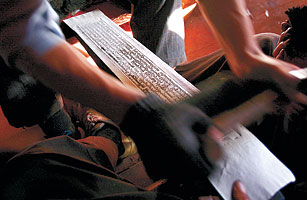
Best Place to Forget About Digital Media
Sichuan, China
Getting to Derge, in Sichuan's montane northwest, is an ordeal. The journey west from Chengdu can take days; I traveled the final stretch in a minibus turned delivery truck, pressed against a freshly butchered yak carcass. But be you a Buddhist or a bibliophile, it's well worth the drive. The town is home to one of the last traditional printing presses in ethnically Tibetan parts of China, the Derge Parkhang. Carved into its 200,000 woodblocks are the great classics of the Tibetan Buddhist canon — generations' worth of history, religion, astronomy and art.
Derge is tucked in a river valley between the Tibetan border and the pass known as Tro-La. In town, the famous press is easy to spot: the ruddy-colored, three-story building is thronged by pilgrims. They circle clockwise, prayer wheels spinning, leading you to the building's central courtyard. Inside, in an airy, second-floor chamber, Tibetan men work in pairs, printing scripture page by page. One spreads black ink on the blocks; the other places, then smoothes, the pages. Then they do it again. Later the onionskin sheets are hung with clothespins and left to dry while the blocks are returned to the stacks.
The press's sutras are evidently made to last. The paper is crafted from the root of an alpine plant whose poisonous pulp has the ability to repel insects and mice and whose composition stands up well to the scourges of time and humidity. The press itself has aged well too. It survived the Cultural Revolution and, after a brief foray into cheap, Chengdu-made ink and paper from Ya'an, has preserved its methods. At this press, tradition has the final word for now.
KNOW BEST: Press Gang
Workers at the Derge Parkhang print a page every four seconds and count the New York Public Library among their customers.